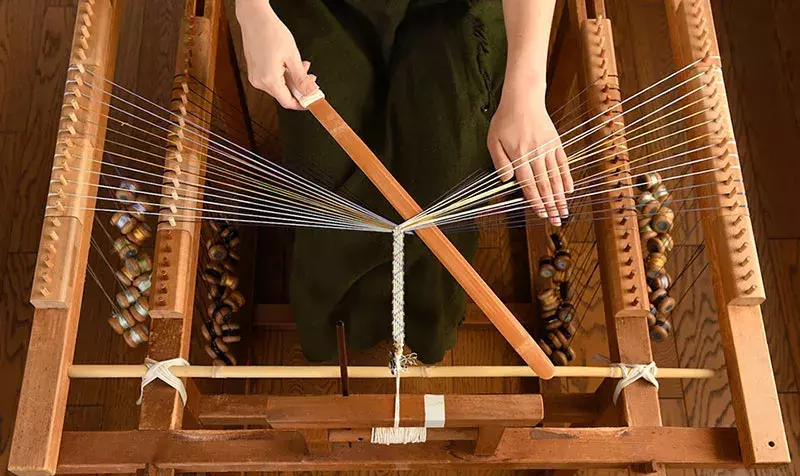
First-Ever U.S. Exhibition Exploring History and Art of Japanese Silk Braiding; Produced by Centuries-Old Braided Silk Cord Company, DOMYO
LOS ANGELES – November 30, 2021 – JAPAN HOUSE Los Angeles, a Japanese cultural destination in the heart of Hollywood, announces its upcoming exhibition “KUMIHIMO: The Art of Japanese Silk Braiding by DOMYO” on display December 11, 2021 to March 6, 2022. The first-ever exhibition in the U.S. exploring the history and art of Japanese silk braiding, or kumihimo (braided cords), the JAPAN HOUSE touring exhibition is produced by Yusoku Kumihimo Domyo (DOMYO), a Tokyo-based company that has been making braided silk cords by hand since 1652.
Though a relatively unknown Japanese artistic tradition outside Japan, elegantly patterned braided silk cords have evolved for many centuries in Japan. The kumihimo tradition began in Japan in the sixth century in the Imperial Court and Buddhist temples, reaching its golden age by the ninth century. Braided silk cords of many styles and patterns were used for aristocratic costumes, interior furnishings and decorations, musical instruments, and religious equipment for temples and shrines. From around the tenth century, kumihimo also was used by the military for swords and armor, later becoming important decorative elements on kimonos and kimono accessories for the well-to-do.
“Kumihimo silk cords have been made in Japan for over 1,500 years, and there is evidence of simple braiding in ancient burial sites dating back five- to six-thousand years ago,” said Yuko Kaifu, president, JAPAN HOUSE Los Angeles. “We’re honored to bring this rich cultural history to the forefront with materials provided by DOMYO, to introduce some of the most important braiding techniques and show the innovative ways kumihimo is used today.”
The exhibition introduces the tradition of braiding and how it is distinct from weaving and knitting and provides a historical overview of braiding in Japan, with replicas of silk braids dating as far back as the seventh century, and examples of diversely patterned cords featured both in ceremonial sword furniture and in clothing. The exhibition also highlights the structure of kumihimo braiding, with large-scale models of the wooden braiding stands over which the strands of thread are laid during braiding. Additionally, the exhibition showcases the future of kumihimo and the ways in which braided silk cords are incorporated into contemporary fashion and design, with new kumihimo designs by DOMYO, several creations by innovative garment modelist Akira Hasegawa who deconstructs antique Western clothing and reworks it with kumihimo, and an installation by the UTokyo Tachi Lab at Tokyo University.
The exhibition also will include related programs, including a webinar on December 15 regarding “The History and Significance of Kumihimo in Japanese Culture.” Additional related hands-on workshops and webinars will be announced soon. Admission to the exhibition is complimentary. Walk-ins are invited and the gallery is open daily from 11 a.m. – 6 p.m.
For more information, visit the JAPAN HOUSE Los Angeles website and social channels: Facebook, Instagram, Twitter, YouTube, and LinkedIn.
ABOUT JAPAN HOUSE
JAPAN HOUSE is an innovative, worldwide project with three hubs, London, Los Angeles and Sao Paulo, conceived by the Ministry of Foreign Affairs of Japan. It seeks to nurture a deeper understanding and appreciation of Japan in the international community. JAPAN HOUSE Los Angeles occupies two floors at Hollywood & Highland. JAPAN HOUSE Los Angeles offers a place of new discovery that transcends physical and conceptual boundaries creating experiences that reflect the best of Japan through its spaces and diverse programs.
Location: 6801 Hollywood Blvd., Los Angeles, CA 90028
Website: www.japanhousela.com
ABOUT YUSOKU KUMIHIMO DOMYO
The company Yusoku Kumihimo Domyo (Domyo), the planner and organizer of this exhibition, was founded in 1652 in the city of Edo (modern-day Tokyo) and today has a shop located in the Ikenohata area of Ueno. As a cord merchant in the Edo period (1603–1868), Domyo primarily produced cords for sword scabbards and handles, and from the Meiji period (1868–1912) onward, it focused on obijime for kimono sashes and haorihimo for tying the open-chested haori jacket. To this day, all of the company’s products are hand-dyed and braided by its in-house artisans. Another important aspect of Domyo’s work is to survey, research, restore, and reproduce historical kumihimo, both at the behest of the Office of the Shōsōin, Imperial Household Agency, and for various temples, shrines, and museums throughout Japan. These activities have yielded a broad wealth of kumihimo-related techniques, knowledge, and documentation that is proving useful in the academic study, preservation, and advancement of kumihimo technology.

